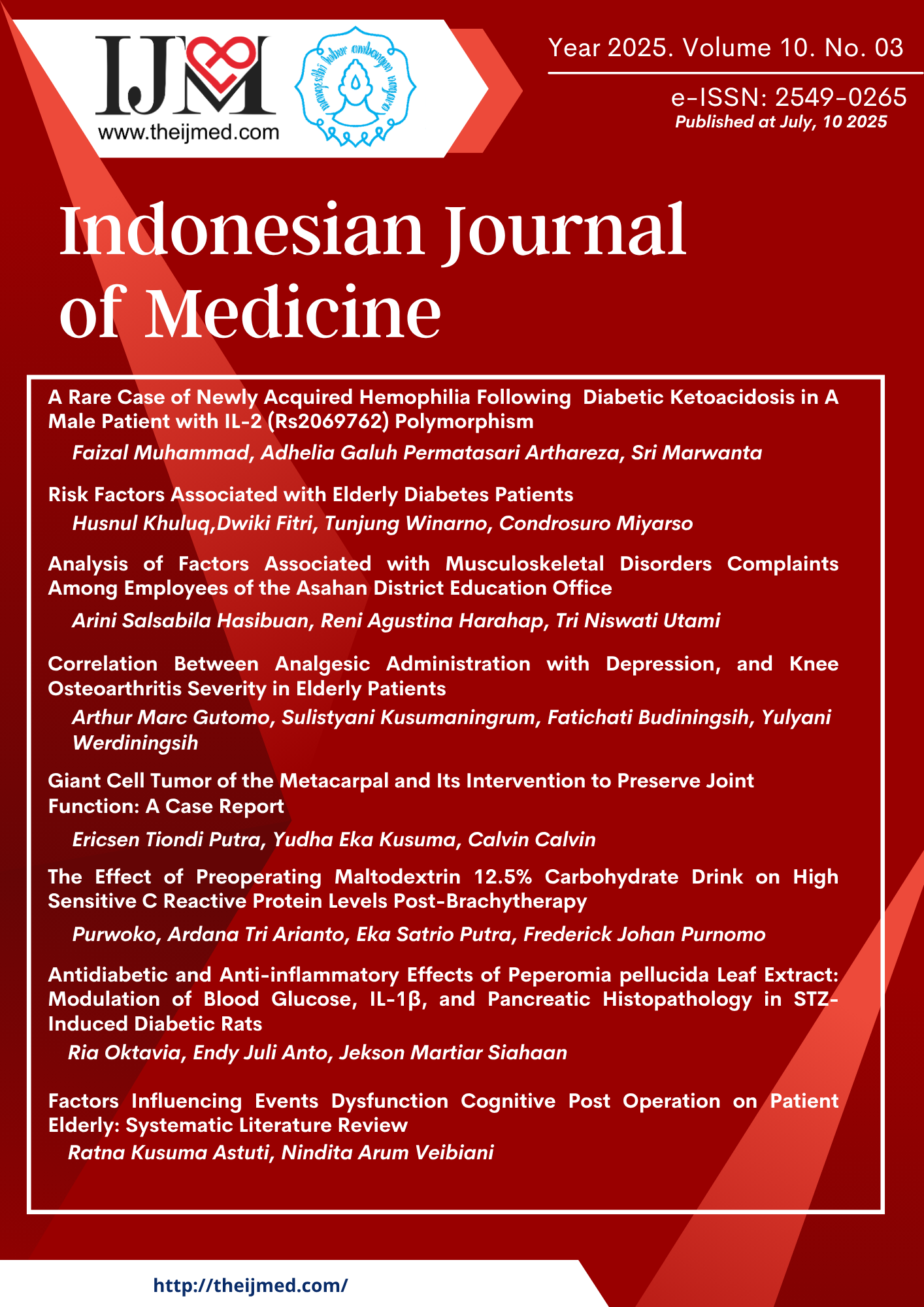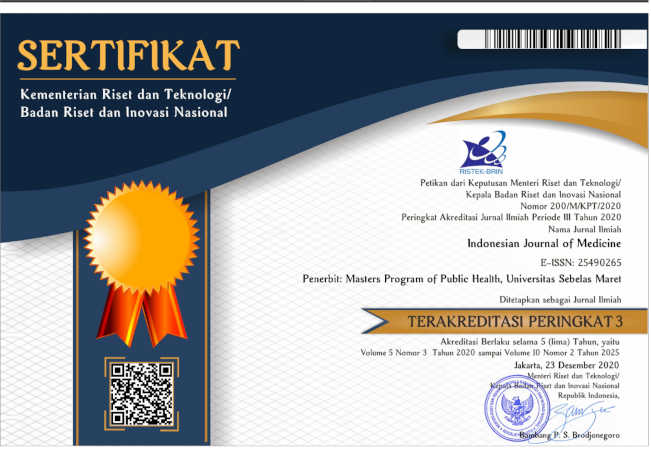Antidiabetic and Anti-inflammatory Effects of Peperomia pellucida Leaf Extract: Modulation of Blood Glucose, IL-1β, and Pancreatic Histopathology in STZ-Induced Diabetic Rats
DOI:
https://doi.org/10.26911/theijmed.2025.10.3.870Abstract
Background: Diabetes mellitus (DM) is a significant global health challenge with a rapidly increasing prevalence. Although synthetic antidiabetic drugs remain the standard treatment, long-term use often leads to adverse side effects, prompting exploration of natural alternatives. This study investigated the therapeutic potential of ethanol extract of Peperomia pellucida (L.) Kunth leaves in diabetes management through comprehensive assessment of glycemic control, inflammatory marker (IL-1β), and pancreatic tissue histopathology.
Subjects and Method: Thirty male Wistar rats were randomized into five groups (n=6): normal control, negative control (STZ-induced), positive control (STZ+metformin 50 mg/kg BW), and two treatment groups receiving Peperomia pellucida extract at doses of 40 mg/kg BW and 80 mg/kg BW, respectively. After 7 days of treatment, blood glucose levels, serum IL-1β concentrations, and pancreatic histopathology were evaluated. Phytochemical screening was conducted to identify bioactive compounds in the extract.
Results: Phytochemical analysis confirmed the presence of alkaloids, flavonoids, tannins, saponins, and phenolics. Blood glucose measurements showed significant intergroup differences on day 0 (p<0.001) and day 7 (p<0.001). The 80 mg/kg BW extract group showed a reduction in blood glucose from day 0 (Mean=312.83; SD=40.92) to day 7 (Mean=281.00; SD=34.86). IL-1β serum analysis revealed significant differences among groups (p<0.001), with lower IL-1β levels observed in extract-treated groups compared to the negative control. Histopathological examination demonstrated improved pancreatic tissue structure in extract-treated groups, especially at higher doses.
Conclusion: Ethanol extract of Peperomia pellucida (L.) Kunth leaves exhibits promising antidiabetic and anti-inflammatory properties in STZ-induced diabetic rats, as evidenced by reduced blood glucose, decreased IL-1β levels, and improved pancreatic histology. These findings suggest that Peperomia pellucida (L.) Kunth is a potential candidate for the development of natural therapies for diabetes management.
Keywords:
Blood glucose, diabetes mellitus, IL-1β, pancreatic histology, Peperomia pellucidaReferences
Alfadul H, Sabico S, Al-Daghri N (2022). The role of interleukin-1β in type 2 diabetes mellitus: a systematic review and meta-analysis. Front Endocrinol. 13:901616. doi: 10.338-9/fendo.2022.901616.
Al-Khayri J, Sahana G, Nagella P, Joseph B, Alessa F, Al-Mssallem M (2022). Flavonoids as potential anti-inflammatory molecules: a review. Molecules. 27(9):2901. doi: 10.339-0/molecules27092901.
Almalki DA, Alghamdi SA, Al-Attar AM (2019). Comparative study on the influence of some medicinal plants on diabetes induced by streptozo-tocin in male rats. Biomed Res Int. 2019:3596287. doi: 10.1155/2019/-3596287.
Arjadi F, Susatyo P (2010). Regenerasi sel pulau Langerhans pada tikus putih (Rattus norvegicus) diabetes yang diberi rebusan daging mahkota dewa (Phaleria macrocarp). Scheff Boerl. 2(2):1–8. https://sinelitab-mas.unsoed.ac.id/google-doc/5975-18/regenerasi-sel-pulau-langerhans-pada-tikus-putih-rattus-norvegicus-diabetes-yang-diberi-rebusan-daging-mahkota-phaleria-macrocarp-lam
Atihuta F (2018). Uji aktivitas ekstrak kombinasi batang dan daun suruhan sebagai antidiabetes (Peperomia pellucida L.H.B Kunth) pada tikus putih. JMP Online. 2(2):205–216. https://ejurnal.ung.ac.id/index.php/jjhsr/article/view/7593
Cardiff RD, Miller CH, Munn RJ (2014). Manual hematoxylin and eosin staining of mouse tissue sections. Cold Spring Harb Protoc. 2014(6):655–658. doi: 10.1101/pdb.prot073411
Chang CC, Yang MH, Wen HM, Chern J (2002). Estimation of total flavonoid content in propolis by two complementary colorimetric methods. J Food Drug Anal. 10:178–182. doi:10.38212/2224-6614.2748
Crissman JW, Goodman DG, Hildebrandt PK, Maronpot RR, Prater DA, Riley JH, Seaman WJ, et al. (2004). Best practices guideline: toxicologic histopathology. Toxicol Pathol. 32(1):126–131. doi: 10.1080/01926-230490268756
Dewi M, Indra W, Noor W (2011). Ekstrak bawang putih (Allium sativum) dan ekspresi insulin serta derajat insulitis pankreas tikus Sprague-Dawley yang diinduksi streptozo-tocin. Media Med Indones. 45(2):105–112. https://ejournal.-undip.ac.id/index.php/mmi/article-/view/3022/2705
Dewi NP, Tandi J, Hasna W (2021). Uji efek antidiabetes ekstrak etanol daun suruhan pada tikus putih jantan yang diinduksi streptozotocin. Farmakologika. 18(1):56–65. https://jfarma.org/-index.php/farmako-logika/article/view/146
Dharma IGBS, Berata IK, Suri S (2015). Studi histopatologi pankreas tikus putih (Rattus norvegicus) yang diberi deksametason dan suplemen-tasi vitamin E. Indones Med Vet. 4(3):257–266. https://ojs.-unud.-ac.id/index.php/imv/article/view/-17505
Dipa I, Sudatri N, Wiratmini N (2015). Efektivitas ekstrak daun sukun (Artocarpus communis Forst.) dalam menurunkan kadar glukosa darah dan mempertahankan jumlah sperma pada tikus (Rattus norvegicus). J Simbiosis. 3(1):317–321. https://scholar.google.co.id/-citations?view_op=view_citation&hl=en&user=JlSIq6cAAAAJ&citation_for_view=JlSIq6cAAAAJ:IjCSPb-OGe4C
Eid H, Martineau L, Saleem A, Muhammad A, Vallerand D, Benhaddou-Andaloussi A, Nistor L, et al (2010). Stimulation of AMP-activated protein kinase and enhancement of basal glucose uptake in muscle cells by quercetin and quercetin glycosides, active principles of the antidiabetic medicinal plant Vaccinium vitis-idaea. Mol Nutr Food Res. 54(7):991–1003. doi: 10.1002/mnfr.200900218
Eizirik DL, Pasquali L, Cnop M (2013). Pancreatic β-cells in type 1 and type 2 diabetes mellitus: different pathways to failure. Nat Rev Endocrinol. 9(7):429–442. doi: 10.-1038/s41574-020-0355-7
El-Bassossy H, Abo-Warda S, Fahmy A (2018). Quercetin protects against diabetes-induced exaggerated vasoconstriction in rats: effect on low-grade inflammation. PLoS One. 13(4):e0195127. doi: 10.1371/jour-nal.pone.0063784
Elmore S (2007). Apoptosis: a review of programmed cell death. Toxicol Pathol. 35(4):495–516. doi: 10.10-80/01926230701320337.
Feldman AT, Wolfe D (2014). Tissue processing and hematoxylin and eosin staining. In: Cheng EC, editor. Histopathology. Humana Press. p. 31–43. doi: 10.1007/978-1-4939-1050-2_3
Ganugapati J, Baldwa A, Lalani S (2012). Molecular docking studies of banana flower flavonoids as insulin receptor tyrosine kinase activators as a cure for diabetes mellitus. Bioinformation. 8(5):216–220. doi: 10.6026/97320630008216
Gumantara MPB, Oktarlina RZ (2017). Perbandingan monoterapi dan kombinasi terapi sulfonilurea-metformin terhadap pasien diabetes melitus tipe 2. Majority. 6(1):55–59. https://www.semanticscholar.org/paper/Perbandingan-Monoterapi-d-an-Kombinasi-Terapi-Pasien-Gum-antara-Oktarlina/a0feefc0d90d1697-a49a94aba3bf2c3fa38ec9e3
Hakim EP, Siahaan JM, Anto EJ, Eyanoer PC (2024). Effect of ethanol extract of suruhan leaves (Peperomia pellucida L. Kunth) on blood sugar levels and macroscopic wounds in male white rats of the Wistar strain (Rattus norvegicus) diabetic ulcer model. Indones J Med. 09(02): 192–206. doi: 10.26911/theijmed.2024.-09.02.06
Harborne JB (1987). Metode fitokimia : penuntun cara modern menganalisis tumbuhan. Bandung: Institut Teknologi Bandung.
Hemmingsen B, Schroll JB, Wetterslev J, Gluud C, Vaag A, Sonne DP, Lundstrøm LH, Almdal T (2014). Sulfonylurea versus metformin monotherapy in patients with type 2 diabetes: a Cochrane systematic review and meta-analysis of randomized clinical trials and trial sequential analysis. CMAJ Open. 2(3):E162–175. doi: 10.9778/-cmajo.20130073.
International Diabetes Federation (2019). IDF diabetes atlas. 9th ed. Brussels: IDF.
Kemenkes RI (2018). Hasil utama riset kesehatan dasar (RISKESDAS). Jakarta: Kementerian Kesehatan Republik Indonesia.
Khan A, Rahman M, Islam S (2008). Antipyretic activity of Peperomia pellucida leaves in rabbit. Turk J Biol. 32(1):37–41. https://journals.-tubitak.gov.tr/biology/vol32/iss1/6/
Majumder P, Kumar K, Arun V (2011). Establishment of quality parameters and pharmacognostic evaluation of leaves of Peperomia pellucida (L.) Hbk. Int J Pharm Pharm Sci. 3(5):67–71. https://www.researchgate.net/-publication/215803307_-Establishment_of_quality_parameters_and_pharmacognostic_evaluation_of_leaves_of_Peperomia_pellucida_L_HBK
Mostafavinia A, Amini A, Ghorishi SK, Pouriran R, Bayat M (2016). The effects of dosage and the routes of administrations of streptozotocin and alloxan on induction rate of type 1 diabetes mellitus and mortality rate in rats. Lab Anim Res. 32(3):160–165. doi: 10.5625/lar.2016.32.3.160.
Muliasari H, Hamdin CD, Ihsan M (2017). Histologi pankreas tikus diabetes melitus setelah pemberian suspensi biji buah makasar (Brucea javanica (L.) Merr). J Ilm Biol. 3(3):115–118. https://www.researchgate.net/publication/328232369_HISTOLOGI_PANKREAS_TIKUS_DIABETES_SETELAH_PEMBERIAN_SUSPENSI_BIJI_BUAH_MAKASAR_Brucea_javanica_L_Merr
Nwokocha CR, Owu DU, Murray J (2012). Possible mechanism of action of the hypotensive effect of Peperomia pellucida and interactions between human cytochrome P450 enzymes. Med Aromat Plants. 1(1):1–5. doi: 10.4172/2167-0412.1000105
PERKENI (2019). Pedoman pengelolaan dan pencegahan diabetes melitus tipe 2 dewasa di Indonesia. Jakarta: PB PERKENI.
Prameswari O, Widjanarko S (2014). Uji efek ekstrak air daun pandan wangi terhadap penurunan kadar glukosa darah dan histopatologi tikus diabetes mellitus. J Pangan Agro-industri. 2(2):16–27. https://jpa.-ub.ac.id/index.php/jpa/article/-view/33
Salma N, Paendong J, Momuat LI, Togubu S (2013). Antihiperglikemik ekstrak tumbuhan suruhan (Peperomia pellucida [L.] Kunth) terhadap tikus Wistar (Rattus norvegicus L.) yang diinduksi sukrosa. J Ilm Sains. 13(2):116–123. doi: 10.35799/jis.13.-2.2013.3055.
Sheikh H, Sikder S, Paul S, Hasan AR, Rahaman MM (2013). Hypo-glycemic, anti-inflammatory and analgesic activity of Peperomia pellucida (L.) Hbk (Piperaceae). Int J Pharm Sci Rev Res. 4(1):458–463. doi: 10.13040/IJPSR.0975-8232.
Tandi J, Rizky M, Mariani R, Alan F (2017). Uji efek ekstrak etanol daun sukun (Artocarpus altilis (Parkinson Ex F.A.Zorn)) terhadap penurunan kadar glukosa darah, kolesterol total dan gambaran histopatologi pankreas tikus putih jantan (Rattus norvegicus) hiperkolesterolemia-diabetes. J Sains Kesehatan. 1(8): 384–396. doi: 10.25026/jsk.v1i8.73.
Wang YW, He SJ, Feng X, Cheng J, Luo YT, Tian L, Huang Q, Liu C (2017). Metformin: a review of its potential indications. Drug Des Devel Ther. 11:2421–2429. doi: 10.2147/DDDT.-S141675.
Wei LS, Wee W, Siong JY, Syamsumir DF (2011). Characterization of anti-cancer, antimicrobial, antioxidant properties and chemical composi-tions of Peperomia pellucida leaf extract. Acta Med Iran. 49(10):670–674.https://pubmed.ncbi.nlm.nih.gov/22071643/
World Health Organization (1998). Quality control methods for medicinal plant materials. Geneva: WHO Press.
Zhang ZF, Lu J, Zheng YL, Wu DM, Hu B, Shan Q, Cheng W, et al (2013). Purple sweet potato color attenuates hepatic insulin resistance via blocking oxidative stress and endoplasmic reticulum stress in high-fat-diet-treated mice. J Nutr Biochem. 24(6): 1008–1018. doi: 10.1016/j.jnutbio.2012.07.009











